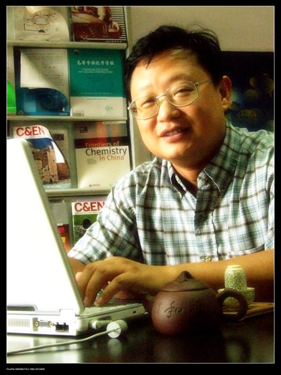

Xiaoda Yang
Ph.D,Professor
Chemical Biology, Bioinorganic Chemistry
Phone: +86-10-82801539
Email: xyang@bjmu.edu.cn
Education:
1997-2000 Department of Pharmaceutical Chemistry, The
1994-1996 School of Pharmaceutical Sciences,
1988-1994 Department of Chemistry,
1984-1988 Department of Chemistry,
Professional:
2006-2010 Vice dean of Department of Chemical Biology,
2003-todate Professor,
2000-2003 Associate professor,
Research Interests:Studies of the molecular mechanisms of pharmacological and/or toxicological actions of metal ions for discovery of inorganic drugs, including: (1) metal-involved signal transduction in diabetes, cardiovascular and neural degenerative diseases; (2) ADMET properties of inorganic drugs and minerals in Traditional Chinese Medicines.
Selected publications:
(1) Wei, Y, Zhang, C, Zhao, P, Yang, X, Wang, K, A new salicylic acid-derivatised kojic acid vanadyl complex: Synthesis, Characterization and Anti-diabetic Therapeutic Potential, J. Inorg. Biochem. 2011, 105: 1081–1085
(2) Xia, Q., Feng, X., Huang, H., Du, L., Yang, X., Wang, K., Gadolinium-induced oxidative stress triggers endoplasmic reticulum stress in rat cortical neurons, J. Neurochem., 2011, 117: 38–47.
(3) Zhou, X., Zeng, K., Wang, Q., Yang, X., and Wang, K. In vitro studies on dissolved substance of cinnabar: chemical species and biological properties, J Ethnopharmacol. 2010, 131, 196-202
(4) Tian, XJ., Yang, XW., Yang, X., Wang, K., Studies of intestinal permeability of 36 flavonoids using Caco-2 cell monolayer model, Int. J. Pharm., 2009, 367: 58–64
(5) Li, M, Li, Y, Chen, J, Wei, W, Pan, X, Liu, J, Liu, Q, Leu, W, Zhang, L, Yang, X, Lu, J, Wang, K, Copper ions inhibit S-Adenosylhomocysteine hydrolase by causing dissociation of NAD+ cofactor, Biochemistry, 2007, 46, 11451-11458.
(6) Yu, S., Hu, J., Yang, X., Wang, K., Qian, ZM, La3+-Induced Extracellular Signal-Regulated Kinase (ERK) Signaling via a Metal-Sensing Mechanism Linking Proliferation and Apoptosis in NIH 3T3 Cells, Biochemistry, 2006, 45, 11217-11225.
(7) Zhang, Y., Yang, X., Wang, K., Crans, D.C., The Permeability and Cytotoxicity of Insulin-mimetic Vanadium (III, IV, V)-Dipicolinate Complexes, J. Inorg. Biochem, 2006, 100: 80-97.
(8) Yang, X.-G., Yang, X., Yuan, L., Wang, K., Crans, D.C., The Permeability and Cytotoxicity of Insulin-mimetic Vanadium Compounds, Pharm. Res., 2004, 21/6, 1026-1033.
(9) Hu, J., Jia, X., Li, Q., Yang, X. and Wang, K. La3+ Binds to Ca2+ Sites of Calmodulin but Results in Altered Conformation and Kinetic Properties as Binding of Calmodulin to Mastoparan, Biochemistry, 2004, 43, 2688-2698.
(11) Yang, X., Hu, Y., Yin, D.H., Turner, M.A., Wang, M., Borchardt, R.T., Howell, P.L., Kuczera, K. and Schowen, R.L., Catalytic strategy of S-adenosyl-l-homocysteine hydrolase: transition- state stabilization and the avoidance of abortive reactions. Biochemistry, 2003, 42, 1900-9.
(12) Yang, X.; Ci, Y-X.; Chang, W-B., Time resolved fluorescence immunoassay with measurement of a europium chelate in solution: dissociation conditions and application for determination of Cortisol", Anal. Chem., 1994, 66, 2590-2594.